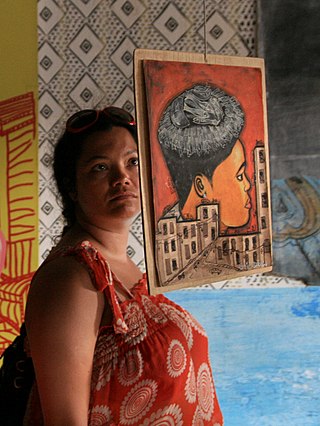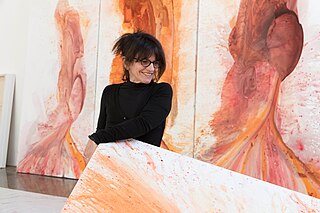Brett Murray is a South African artist mostly known for his steel and mixed media wall sculptures. He was born in Pretoria, South Africa. Murray has a master's degree in fine art from the Michaelis School of Fine Art, 1989. Referred to by critic Brenda Atkinson as "the dark prince of South African pop (art)", Murray is one of the country's most popular artists, often using easily recognisable media images with the addition of a subversive and bitterly funny twist. Murray's work addresses the wars of the cultures, the clash between Afrocentrism and Eurocentrism, the old and the new South Africas. "With my work I hope to critically entertain. Through satirical and tragic reflections on South Africa, I hope to shift people's perspectives and change people's minds, indulgent, arrogant and pretentious as this might sound," he says. More recently, his work has explored his own personal experiences and identity. Murray was also the founder of the sculpture department at Stellenbosch University.

The Iziko South African National Gallery is the national art gallery of South Africa located in Cape Town. It became part of the Iziko collection of museums – as managed by the Department of Arts and Culture – in 2001. It then became an agency of the Department of Arts and Culture. Its collection consists largely of Dutch, French and British works from the 17th to the 19th century. This includes lithographs, etchings and some early 20th-century British paintings. Contemporary art work displayed in the gallery is selected from many of South Africa's communities and the gallery houses an authoritative collection of sculpture and beadwork.
Willie Bester is a South African painter, sculptor and collage artist. He is best known for his role in the protesting of the apartheid system through his artwork. He currently lives in Kuilsrivier, South Africa with his wife, Evelyn and their three children.
Berni Searle is an artist who works with photography, video, and film to produce lens-based installations that stage narratives connected to history, identity, memory, and place. Often politically and socially engaged, her work also draws on universal emotions associated with vulnerability, loss and beauty.

Willem Boshoff is one of South Africa's foremost contemporary artists and regularly exhibits nationally and internationally.
Buysile "Billy" Mandindi (1967–2005) was a black South African activist-artist who participated in a landmark protest in Cape Town in 1989, the so-called Purple Rain Protest. Later, still covered with the purple dye that riot police sprayed on protesters, Mandindi created a linocut celebrating the spirit of freedom.
Minnette Vári is a South African artist known primarily for her video installations. Born in Pretoria, Vári studied fine arts at the University of Pretoria where she obtained her master's degree. She lives and works in Johannesburg.

Tracey Rose is a South African artist who lives and works in Johannesburg. Rose is best known for her performances, video installations, and photographs.
Nicholas Hlobo is a South African artist based in Johannesburg, South Africa. He was born in 1975 in Cape Town. He earned a Bachelor of Technology from Technikon Witwatersrand in 2002. He creates large sculptural works that are expansive masses that at once feel oozey, voluptuous, and highly structured. Through his work, he navigates his identity as a gay Xhosa man in South Africa and reevaluates the definitions of masculinity and sexuality in his country. The variance between femininity and masculinity is created by his use of materials such as rubber inner tubes, ribbon, organza, lace, and found objects. Hlobo cuts and sews objects back together to symbolize the idea of the healing that comes after a tearing apart in order to express his interest in the history of colonization in South Africa as well as the overt and covert ways that colonization occurs in modern life.

Diane Victor, is a South African artist and print maker, known for her satirical and social commentary of contemporary South African politics.
Athi-Patra Ruga is a South African artist who uses performance, photography, video, textiles, and printmaking to explore notions of utopia and dystopia, material and memory. His work explores the body in relation to sensuality, culture, and ideology, often creating cultural hybrids. Themes such as sexuality,Xhosa culture, and the place of queerness within post-apartheid South Africa also permeate his work.
Doreen Southwood is a South African artist, designer, and boutique owner based in Cape Town. She works in a wide variety of media in her artwork, producing sculptures, objects, prints, film, and more, which she often bases on personal experiences and self exploration. Her candidness regarding personal flaws and the cycles of repression and coping that accompany conservative, middle class, Afrikaans upbringing inform much of her work, calling attention to ways in which women are silenced or otherwise repressed in that space.

Kathryn Smith is a South African artist, curator, and researcher. She works on curatorial projects, scholarly research, and studio practices, while her art deals with uncertainty, risk, and experimentation. She works in Cape Town and Stellenbosch. Her works have been exhibited and collected in South Africa and elsewhere. In 2006, she was appointed senior lecturer in the Department of Visual Arts at the University of Stellenbosch and head of the Fine Arts Studio Practice program. She took a break in 2012/2013 to read for an MSc at the University of Dundee.
James Webb is a South African artist best known for his interventions and installations incorporating sound. His sound installations place special emphasis on the sourcing and presentation of the sound clips, as well as the social significance and context of these sounds. Often referred to as a "collector of sounds," Webb is interested in the role that aural events play in our everyday life. The physical presentation of the work, including the installation space and the logistics of speakers, are also deliberate choices for Webb.
Mary Sibande is a South African artist based in Johannesburg. Her art consists of sculptures, paintings, photography, and design. Sibande uses these mediums and techniques to help depict the human form and explore the construction of identity in a postcolonial South African context. In addition, Sibande focuses on using her work to show her personal experiences through Apartheid. Her art also attempts to critique stereotypical depictions of women, particularly black women.
Jane Alexander is one of the most celebrated artists in South Africa. She is a female artist best known for her sculpture, The Butcher Boys. She works in sculpture, photomontages, photography and video. Alexander is interested in human behavior, conflicts in history, cultural memories of abuse and the lack of global interference during apartheid. Alexander's work is relevant both in the current Post- Apartheid social environment in South Africa and abroad.

Penny Siopis is a South African artist from Cape Town. She was born in Vryburg in the North West province from Greek parents who had moved after inheriting a bakery from Siopis maternal grandfather. Siopis studied Fine Arts at Rhodes University in Makhanda, completing her master's degree in 1976, after which she pursued postgraduate studies at Portsmouth Polytechnic in the United Kingdom. She taught Fine Arts at the Technikon Natal in Durban from 1980 to 1983. In 1984 she took up a lectureship at the University of the Witwatersrand in Johannesburg. During this time she was also visiting research fellow at the University of Leeds (1992–93) and visiting professor in fine arts at Umeå University in Sweden (2000) as part of an interinstitutional exchange. With an honorary doctorate from Rhodes University, Makhanda – Siopis is currently honorary professor at Michaelis School of Fine Art, University of Cape Town.

Wayne Barker, South African visual artist. Barker is based in Johannesburg. He rose to prominence in the late 80s, at the height of political unrest under the Apartheid regime. His work has featured in several global biennales, art fairs and important retrospective exhibitions. He works in various mediums, including but not limited to painting, printmaking, sculpture, video, performance and installation. In addition to collaborations with other artists, Barker has collaborated with the Qubeka Beadwork Studio based in Cape Town, to realise large scale glass beadworks.
Lisa Brice is a South African painter and visual artist from Cape Town. She lives in London and cites some of her influences as her experiences growing up in South Africa during a time of political upheaval, and from time spent living and working in Trinidad.
Mmakgabo Mmapula Mmangankato Helen Sebidi is a South African artist born in Marapyane (Skilpadfontein) near Hammanskraal, Pretoria, who lives and works in Johannesburg. Sebidi's work has been represented in private and public collections, including at the National Museum of Women in the Arts, Washington and New York, the Smithsonian National Museum of African Art, New York, and the World Bank. Her work has been recognised internationally and locally. In 1989, she won the Standard Bank Young Artist award, becoming the first black woman to win the award. In 2004, President Thabo Mbeki awarded her the Order of Ikhamanga in Silver – which is the highest honor given to those considered a "national treasure". In 2011, she was awarded the Arts and Culture Trust (ACT) Lifetime Achievement Award for Visual Art, while in 2015 she received the Mbokodo Award. In September 2018, Sebidi was honoured with one of the first solo presentations at the Norval Foundation in Cape Town – a retrospective entitled Batlhaping Ba Re.











